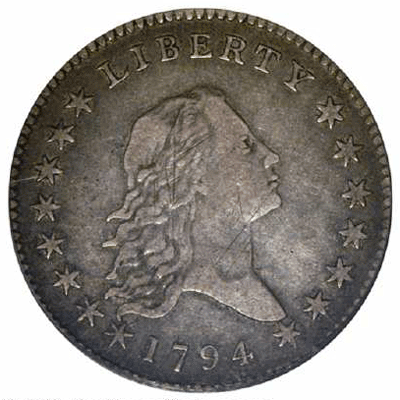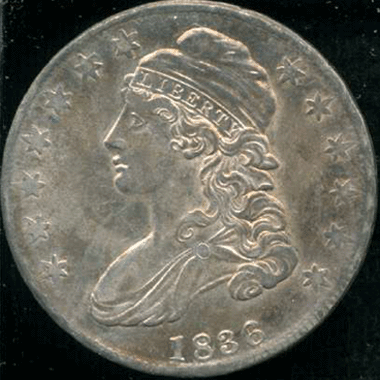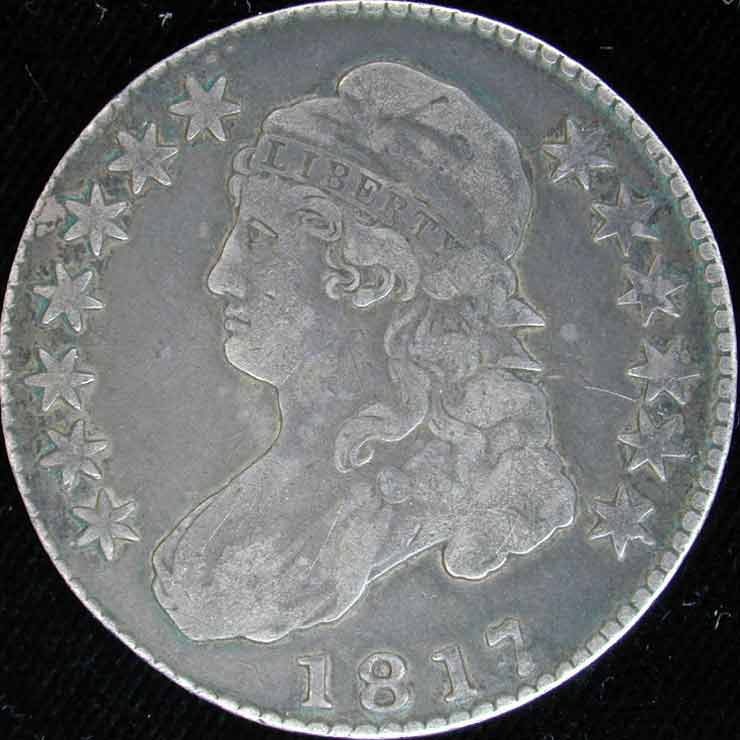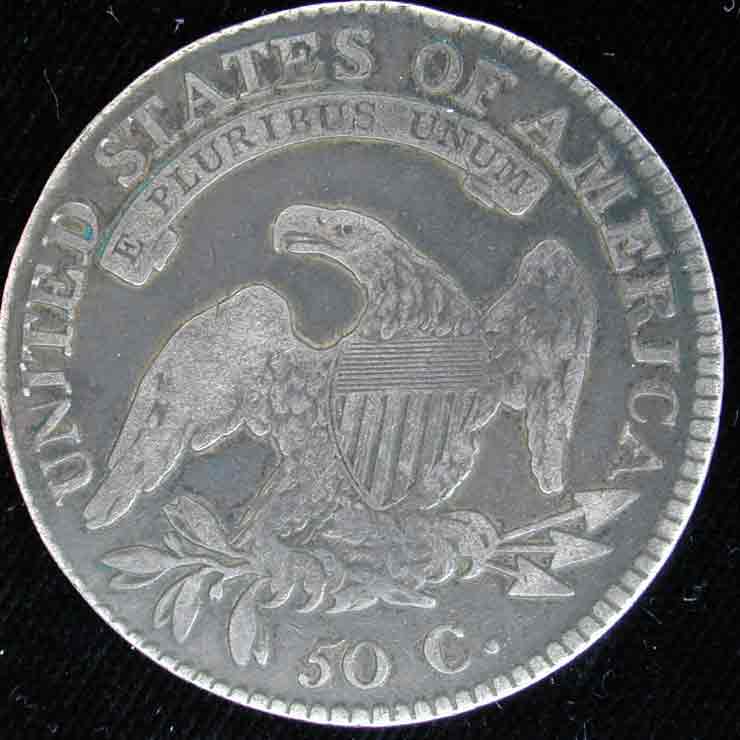

 |
Bust Half Dollar Auction and Sales Results |  |
| The 1817/4 Half-Dollar |
The 1817/4 half-dollar is the classic rarity of the Bust Half series with only 10 examples known. The 8th example was discovered by contracter George Williams in mid 2005 while raking a load of fill dirt. This coin is an example of O.102a. It was slabbed by ANACS as having extra fine 40 details but with some corrosion. Sheridan Downey considers it to be in seventh place in the condition census despite the xf40 details. The coin was sold by Heritage on 1/5/2006 in to a mail bidder for $253,000 with the buyers premium. The 9th example was found by a Colorado women in family inheritance and was reported in the 12/17/2007 issue of Coin World. ICG slabbed the coin as very good 8 with obverse scratch. This coin will probably be in last place in the condidtion census. As of 2/2008 the coin has not been up for public sale. The 10th example was found in the estate of an old time collection and passed to the collection of a Louisiana Bust Half collector for a six figure amount in July, 2012. The coin has been graded Very Good 8 by PCGS. The history of the discovery of the 1817/4 is presented below, with the kind permission of Sheridan Downey. Based on the study of dentil counts for the obverse dies by David Finkelstein in the John Reich Journal of October, 1993 it seems likely that the 1817/4 obverse started as a leftover 1814 and was modified to 1817/4 later. This obverse was never used in 1814 before being modified. This is the case with most overdates/blunders for the early half dollars. The only exception is the obverse of 1806 O.104 which saw use in 1805 as O.105 and then was modifed from 1805 to 1805/6. Below are the obverse and reverse of the Elton Dosier/John Tidwell specimen of the 1817/4 which is graded Fine 12. |
 |
 |
What follows is the write up for lot 8 from Sheridan Downey's mini auction for the 2002 ANA Convention: |
 |
|
LOT 8 – 1817/4 O.102a R.7 VF 25 THE FLOYD AND BETTY FARLEY SPECIMEN |
We shall start with the basics. I believe this coin to be the third finest of but seven known 1817/4’s, behind the Eliasberg and Meyer specimens. Floyd Farley [BHNC #6] paid $5,000 to Stewart P. Witham [BHNC #1] in May 1968. The coin grades VF 25. (It has never been sent to a grading service.) The reverse is rotated 30° counter-clockwise. It was struck from misaligned dies, the reverse on-center and the obverse appearing off-center towards 11 o’clock. A 1-mm slice of raw planchet lies below the date. It is an intermediate die state with a thin die break bisecting the obverse from above the cap to the edge, right of the date. You cannot see the break in the accompanying photo and may need a loupe when viewing the coin in person. The overdate is crystal clear, including the stand, base and crossbar of the underlying 4. The coin is a pleasing light silver-grey with a bit of luster in protected areas. It was lightly wiped and displays some hairlines, nothing offensive. I detect hints of prooflike surfaces under the light grey patina. For several years in the 1970's and early 80's Floyd Farley held an example of every die pair of the Capped Bust Half-Dollars described in Al Overton's 1970 2nd Edition, plus a few others that surfaced after 1970. He was the only collector to have accomplished this feat until his protégé Charlton Meyer, Jr. completed his set in 1996. A few years back, as macular degeneration slowly impaired his eyesight, Floyd began to sell his coins to friends and, via your cataloguer's Mail Bid Sales, to the collecting community. His R.7 1823 O.113, a discovery coin, sold in May 2001 [MB 26]. His 1827 O.149, the finer of but three known, sold this past April in Mail Bid Sale No. 27 One bust half-dollar remained: in his words, The Overdate. Floyd always referred to The Overdate as "Betty's coin." It was clear that he had no say in its disposition without Betty's okay. Shortly after the loot from MB 27 arrived in Arizona Floyd called. He was simple and to the point, "Betty says to sell it." The Farleys' thirty-two year stewardship of the coin now closes. This is the fourth Overdate I've had the pleasure to own or handle. The Dosier (thrice), Overton and Burke specimens came earlier. A cool perspiration always dampens ones hands when the King of half-dollars first spills from its envelope. This American numismatic treasure, replete with beauty, history and rarity will soon grip its new custodian with unparalleled pride of ownership. A peek at its history is in order. In January 1816 John Reich was in his ninth year of service as Assistant Engraver for the United States Mint. Reich, from the time of his employment in September 1807, was regarded as one of the most skilled engravers in the country, having learned his trade in Germany before immigrating to the United States (as an indentured servant) in 1800. His talent certainly exceeded that of the Chief Engraver, Robert Scot. (Scot designed the earlier Flowing Hair and Draped Bust half-dollars.) Reich's first task, in 1807, was to redesign and prepare master dies and hubs for gold and silver coinage. The now familiar Capped Bust design is his enduring contribution to American numismatics. On the 10th of January 1816 the Mint delivered a token mintage of 47,150 half dollars for the year 1815. The entire mintage was coined from a single set of dies; the obverse die was prepared and date-punched in 1812, but had gone unused. In 1815 it was recovered, reworked and a "5" was punched over the partially effaced "2." The overdating of unused dies was a common occurrence in the early years of the mint. In seven of the eleven years preceding 1816 the mint produced "overdated" half-dollars. Hours after the delivery of the 1815/2 half dollars a fire in the Mint ruined its rolling mills. The rolling mills, of course, were needed to convert gold and silver bullion into strips from which planchets were prepared. Without planchets, no gold or silver coins could be struck in 1816. One might suppose that Reich had plenty of time in 1816 to prepare working dies for 1817. Apparently not. The first two obverse dies used in 1817 were overdates. The 1817/3 came first, then the 1817/4. The two1817 overdates share a common edge die with the earlier 1814 O.103 and O.106, the 1815/2 and with the later struck 1817 O.110. (Remember, Overton's attribution numbers do not correspond with emission order.) Reich resigned in March 1817. His eyesight was failing and he was unhappy with the absence of a single pay raise during his 10-year employment. Scot immediately set to work "fine tuning" the hub from which working dies were prepared. We readily notice his addition of curls to Liberty's coif, yielding a more elaborate and delicate hairstyle. Reich, we now know, prepared only one obverse die in 1817 - and it was not used until 1818. From the advent of the Capped Bust design in 1807 until he left the Mint in early 1817 Reich placed a covert "signature" on the obverse dies prepared during his tenure: a small notch on the outside point of star 13. Of the 10 obverse dies used in 1817 only the 1817/3 and 1817/4 have this notch. (These dies, of course, had been prepared in 1813 and 1814.) The single obverse die used to coin the 1818/7 O.101 and O.103 also has the notch, along with large 8's and the early style hair curls. We skip forward in time to 1930. E.T. Wallis of the California Stamp Company in Los Angeles tells the world that he has discovered a new variety of 1817 half-dollar, with the 7 "cut" over a 4. (See photos, top of next page.) He also claims that the reverse is new, "…in as much as the "I" in UNITED and AMERICA both have a broken foot, the right half of the serif being broken away diagonally." The latter claim, of course, was incorrect. M.L. Beistle, in 1929, recognized this reverse on his variety B.2-b, noting, inter alia, "....A letter J is in AMERIJCA." [Sic - should read AMERIJA.] In 1881 Captain John Haseltine reported a similar characteristic on his variety H.3: "... the lower part of I towards C in 'America' is defective; looks as if sliced off;...." The reverse die, we now know, appears on the relatively common 181.7 "punctuated date," O.103. |
 |
On the important matter, however, Wallis was not mistaken. He had found a new obverse die, an 1817 over 14! Earthshaking news, we would expect. But not in 1930, with the Great Depression just settling in. Standard catalogues of the day ignored Wallis' find. Beistle's book was already published. Few people collected half-dollars by die variety and fewer still would embark on the endeavor during an economically catastrophic era. In short, Wallis' unique, "EXTREMELY FINE" 1817/4 half-dollar, "showing practically no wear," went unnoticed notwithstanding a short blurb at page 689 of the October 1930 edition of THE NUMISMATIST, noting that Newcomb and Beistle had confirmed Wallis' find of an 1817 over 14 half-dollar. Sometime between 1940 and 1942 Ed Johnson, an Ohio coin dealer, located a second example. In all respects, except for grade, it matched the Wallis coin. The circumstances surrounding Johnson's acquisition and it's later sale to BHNC co-founder Stewart P. Witham are recounted in a lively "Memo to File" that Witham typed for himself on May 27, 1966, nine days after he purchased Johnson's coin. I have the original and reprint it here for your reading pleasure. Bracketed "[ ]" words are mine, not Witham's. |
Ed Johnson, of Wooster, Ohio bought this coin which is considered to be Overton 2, Grade Fine to VF, with a typical weak reverse, from a New York dealer in the early years of WW II. The dealer sold Ed several coins as overdates, including this 1817/14. It was sold as a punctuated [date] 1817, but Ed was sure that it was not such a coin. It wasn't until further contingent study that he realized that it was 1817/14, which at that time had not been completely reported in the coin press. The coin had actually been discovered and was first reported in the October 1930 NUMISMATIST, verified by Newcomb and Beistle, but it was never carried on from there and not entered into the standard catalogue of the day. Thus Ed took the coin with him to the West Coast and conferred with Abe Kosoff, who had known about it or had seen one of these coins. He [Ed Johnson] was offered $500 for it on the spot; Adolph Menjou was interested but Ed would not sell. He retained the coin as a symbol of his business, using it on his stationery and on his cards for all of the ensuing years.... I bought the coin from Ed on May 18, 1966 for $4,850. There are only three other coins of this overdate known to the collecting fraternity today [1966]. The first is in the hands of Eliasberg of Baltimore. It was bought by Eliasberg from Al Overton [in 1953]. Al was the man who publicized the 1817/14 through his coin Half-Dollar Auction Catalogue of April 1959 [and earlier, in his Mail Bid Sale of January 23, 1953], in which he listed additional varieties of half-dollars beyond those described and listed in the Beistle book. The collecting fraternity has maintained for sometime that there were only two of these coins known; one of them was the Eliasberg coin and the other the coin which now rests with Paramount-Empire. [The Meyer specimen, as it is now known.] This coin, listed as XF, was offered for sale in the [Paramount Century Sale] auction of April 1965. It is believed that it did not sell [and] was bought back for the account of Empire [operated by Q. David Bowers and James Ruddy]. They had acquired the coin, incidentally, from an upstate New York industrialist [Hazen Hinman] who had committed his collection to Empire for this sale. I am told by John Cobb of Mountain View, California that the Paramount/Empire coin is now for sale over the counter at $7,500. Cobb has attempted to buy this coin which is XF, but to this point he has been unsuccessful. John Cobb acquired an 1817/14 from Dan Messer in New York City. Dan paid $1,500 and sold it to Cobb for $3,000. Cobb listed it in his Sale Catalogue of November 1965, calling it VG to Fine, suggesting $8,000 as a price. He advised me in personal correspondence that he would accept no less than $5,000 for the coin or he would buy it back. Because the coin exhibited a very large ding on the reverse I did not bid on it and I think this is the reason bidding was restricted. [In 1969 this coin found its way to the Overton Collection.] The coin census of the 1817/14 thus lists the Overton/Eliasberg coin in XF; Empire/Paramount coin, their figure is XF; the Johnson/Witham coin in Fine to Very Fine; and the Messer/Cobb coin in VG. … After Overton had publicized the coin through his auction catalogue it was listed in the Red Book and called Unique. [This was an obvious] error because Overton described two coins at the time he disclosed the existence of one. Subsequently, this classification was changed and it is now referred to as Extra Rare. |
Less than two years after Witham wrote his May 1966 Memo a fifth 1817/4 surfaced. In March 1968 Don Taxay sent Witham a VF specimen for authentication. Taxay told Witham the coin belonged to a Pennsylvania collector, Thomas "Peffer" or "Pfeffer," and was for sale. Witham called his friend, Floyd Farley, quoted Taxay's asking price and shipped it out. Farley did not let it escape. Two more 1817/4's have since surfaced. A roster of the seven pieces, including the provenance of each 1817/4, appeared in Mail Bid Sale No.22, page 28. It will not be repeated, but here is a short description of the pieces, in order of discovery.